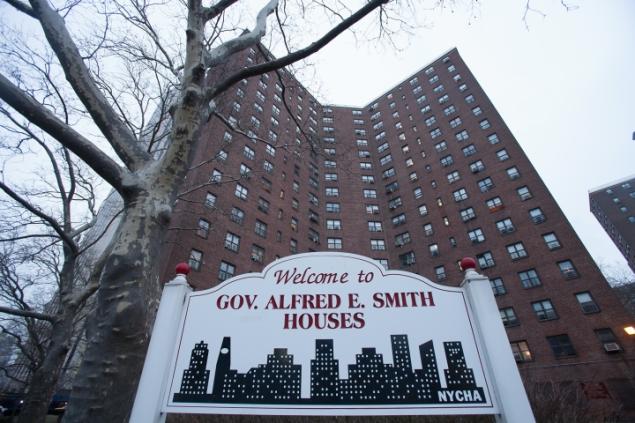The New York City Housing Authority (NYCHA) announced a bold new plan to pay for much-needed housing repairs: building three million square feet of luxury housing on top of “underused” playgrounds, community centers, parking lots, and baseball diamonds on NYCHA property. The 4,330 new apartments would be built in the Lower East Side, lower Manhattan, and the Upper East and West Sides, some of the city’s most expensive real estate markets. The housing authority will lease the land to private developers, who will be given a 99-year lease and payments will be frozen for the first 35 years.
20 percent of the new units will be affordable housing for families of four making $50,000 or less, while the other 80 percent will be market-rate. This is the first time NYCHA has ever proposed building market-rate housing. At the Baruch Houses on the lower East Side, where NYCHA seeks 175,000 square feet of new housing, rent in a private building across the street is $3,100 for a one-bedroom apartment, according to NY Daily News. The priciest NYCHA housing as of yet are the Chelsea Houses, which are middle-income and capped at an income of $167,000/ year for a family of four.
Current residents are worried about the changes to the community that the new developments would bring. According to the NY Daily News, the executive board of the Smith Street Houses tenant association opposes the plan, worrying about the “socialization of our community with new residents who have higher economic means than our residents,” the board wrote in a Jan. 17 letter to NYCHA. The association is worried about public housing tenants being treated poorly within their own communities. The proposed new tower at Smith Street would face away from the public housing and have its own private entrance.
The agency expects to earn between $31-50 million annually from the new leases, which would help ease the consistent $60 million annual budget shortfall and confront the backlog of 420,000 repairs. A mayoral spokesperson called it an “innovative plan to generate hundreds of millions of dollars of value will allow us to reinvest in NYCHA.” According to Alexis Stephens, in early coverage of the issue for ShelterForce, “NYCHA argues that the revenues from these sales outweigh the quality of life concerns that have been raised by residents and advocacy organizations.” However, as Stephens points out of developments slated for NYCHA open spaces, “Given what residents and other stakeholders are saying about how they value their gathering spaces, a holistic approach to the creation of ‘public housing neighborhoods’ should be required to take into account the benefits of open space as well.”
There has yet to be been a clear timeline put forward as to when developers will submit proposals, or the amount of influence existing residents will be able to have over the new construction. However, considering NYCHA’s budgetary problems and the constant need for new housing in New York, it seems very certain that this plan will proceed forward. The effects of market rate housing immediately adjacent to subsidized housing have sparked gentrification concerns, especially in the rapidly changing Lower East Side. Dalton Conley, a professor at NYU, states “I always thought that gentrification would extend right up to Avenue D. I never imagined gentrification would have infiltrated the public housing projects themselves.”

1 Comment
Comments are closed.